Degas and the dancers
[Hat tip: Open Blogger at Ace’s.]
When I was a child I used to greatly admire Degas’ dancer paintings. My family had a reproduction of one of them, and I used to study it and marvel at how well it expressed how ballet dancers stand, pose, and move.
Most artists cannot draw ballet dancers. To the unschooled observer their attempts might look just fine, but a trained dancer (that’s me, for example) knows what’s off, and there’s almost always something that’s not right.
Degas gets it right. Of course, ballet has changed since the time he painted, but not that much, and if you look at old photos or very old movies you will see how well he managed to match what he was seeing. His dancers in repose have the weariness of the physically spent, and yet even then they retain the exaggerated turnout of their ballet training. In movement, there’s the grace and the strain. You can see their unnatural postures and the slight but somehow beautiful deformation of the leg and feet, the hyper-extended knees (I’ve got ’em) and the rolling in of the arches that sometimes happens in spite of dancers’ best efforts not to give in to it.
Degas was probably the most intensely accurate observer of movement who ever painted. He isn’t looking for the light and decorative, as most painters of ballet dancers are. His dancers have weight and awkwardness and stress, and they go beyond the pretty into the true. I have yet to see a Degas ballet painting—and there are many, many—that isn’t superior to every other painting of dancers I’ve ever seen.
Some of my Degas favorites are charcoal sketches, some are full-fledged paintings. I especially like his renditions of dancers fussing with their shoes or their garments, something dancers are constantly doing in real life:
There are so very many it’s hard to choose, but I’m very fond of this one adjusting her shoulder strap:
This next drawing in particular demonstrates Degas’ exceptionally keen eye for movement. It’s not really pretty; can you see the slight strain in the shoulders and necks of the dancers, trying their best for height of the raised leg and extreme turnout of both that one and the supporting leg and foot? It’s very very common for dancers to take the strain into the upper body like that, and yet it’s subtle. Degas fully captures it:
You may be very familiar with Degas’ statue of a young dancer, with her fabric dress and the ribbon in her hair. Although the sculpture is very popular now, it was controversial in Degas’ time; the story can be found here. I imagine that she’s resting a bit as she watches the teacher set the next combination:

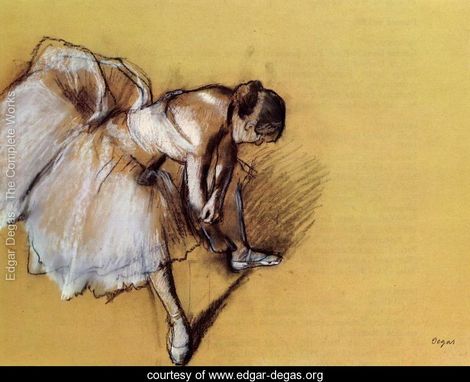
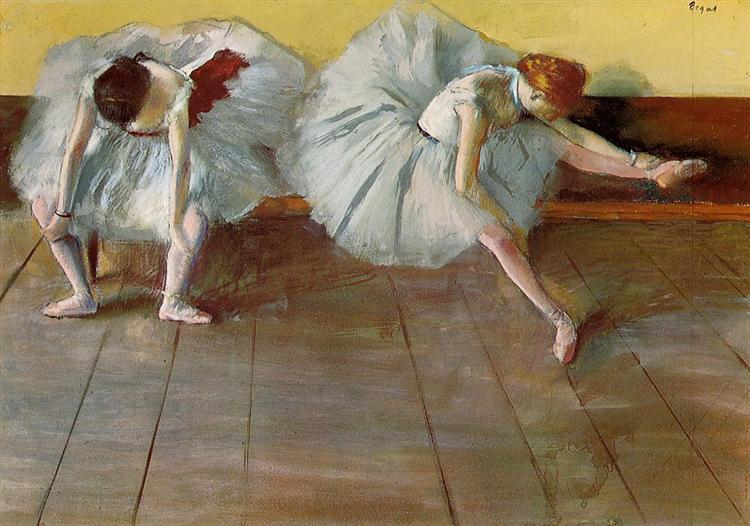
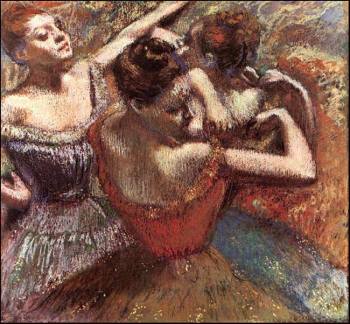
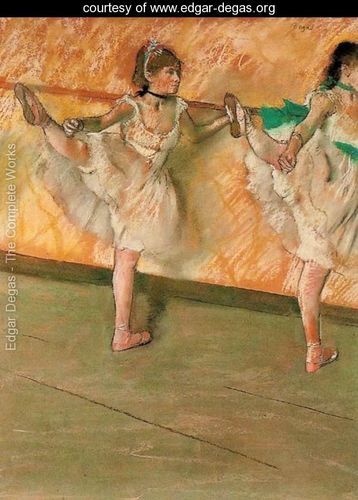
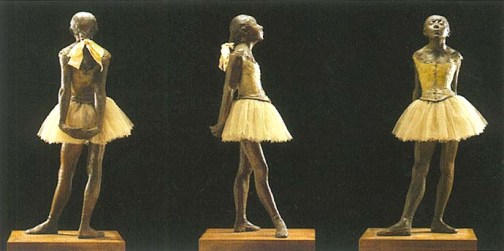
He would be arrested today…
Men can’t even be in a park alone
Watching young girls and drawing them would be a huge no no
Piss Christ is safer and more lucrative thanks to our overlord
And the list suskind puplished
Neo,
A really nice interpretive post. I’ve always enjoyed Degas, but now enjoy the works even more. It’s always exciting to hear an “inside view” on any work of art because it clarifies a sensitivity of the artist (when, in fact, such a sensitivity is present) which the unschooled eye or ear misses from lack of experience.
Thanks!
MOMA has an exhibition of Degas monotypes than runs into July. I saw a report on the exhibit yesterday. Some of the monotypes are shown next to paintings based on them and some are of his dancers. It looks like an interesting show.
Degas has always existed for me at the outer limits of my ‘radar screen’ perhaps because while I appreciate the beauty of ballet, I have never been drawn to it. Perhaps that is also why, until this post I was unaware of and cannot recall ever seeing Degas’ sculpture. I read the article linked to about its controversial debut and it makes for fascinating reading, especially when contemplating the common reaction to it at the time.
Degas was our artist for our last school term (homeschooling, we choose an artist for each 12 week term and get to know him/her). It’s nice to have some more depth to add to what we learned. You’re good for that kind of stuff. It’s why I keep reading here. That, and you’re usually just plain right. Thanks. 🙂
Neo Most artists cannot draw ballet dancers. To the unschooled observer their attempts might look just fine, but a trained dancer (that’s me, for example) knows what’s off, and there’s almost always something that’s not right.
thats because most artists do not actually see what they percieve… they percieve what they see
you have seen my portraiture neo…
why did i do that young boy and others?
[wish you would put it up for others to see in terms of portrait skill and i could point out a few things as to how such things are created and what people do or dont look for or see or dont see]
because humans have special processing of faces, and when you do a face, you cant get away with much, and the closer it is to realism, the harder it is to get away. the more real, the less hidden in style… (then there is the ability to make real more real than real or tastier, by things like turning up saturation)
its also because most of us are not observant either.
if you want to see the artwork of a person that is VERY observant, and one you already covered, take a look at sargent’s portrait… (the one where it was changed several times from man to dog)
specifically Madam X
if you look at the picture, there is a table next to her and her arm is kind of holding the edge of the table behind her. Sargent could percieve what he saw, and so could draw or paint what he saw to a degree where he added stuff that others dont paint cause their perception does not see it
there is a fundemental biological difference between womens arms and mens arms… if one stands at the edge of a table, and puts their palms upwards, and edges of hands together on the table… (kind of like making a bowl, but aligned by the table edge)… women can touch their elbows together and men cant.. (dont tell the feminists, but its key to being formed for working with children, and for me, fighting without your arm breaking and able to xmit power in a strike).
anyway…
its a simple enough test and show..
however, most artists who are not aware of this, do not include that in their paintings or drawings… others who are not aware but can see what they percieve, include it without knowing, and the third is those that know, can then see what they didnt see before, once they are told… (but this is not as good, as they fail if not told)
anyway… the odd crook in her arm, that grabs your attention, sargent uses to make creat composition… ie. you think something is off when he captured something real, then follow her arm downwards (As we are programmed to go to the hands not the shoulder like an arrow), reach the table that cuts her palm, and brings you back to her in the composition just as the edge of the table brings you into the painting and to the same spot. her arm being on the downslope of the table curve makes your eye go to her, not to the edge of the artwork…
composition is often about creating such things that make ones eyes go round and round and get captured inside the work.
take a look at the very young girls at the rail. its bad to divide the canvas… this would be bad composition. but if you look, the bar that divides the scene, is prevented from doing so by the shoulders of the girl… the bar then gets hidden by the two. her eyes look at the back of the other girl, whic moves you to her head, and if you notice, he added a bit of extra black around her arm, so that her arm woudld pull you back into the compositio rather than leave, and so reach her leg, which then brings your eye back to the other girls arem, and so back to the subject.
the lower line is also divided and so prevented from dividing the canvas again, but the two legs, which the feet bring you back to the line and not to the large empty space.
the empty space acts like a wall.. your eyse dont want to traverse it.
you can see this concept being used in the other degas paintings the first and the third in your stack
the first painting puts the subject in an island of blank space, which is a wall around the interest and so, keeps your eye on the subject. the arms and feet and gaze form a circular composition reference where once your in the center where her front is, your stuck there.
the third image, the one to focus on, breaks some rules and adds some alternatives to fix the broken rule. for instance, her gaze to the shoulder in fixing the strap makes you look towards her elbow, now your attention is divided between following the arrow of her elbow off the canvas, or circling around to her hand. he prevents you looking off canvas by putting a blan area there, which is a wall your eye has to skip over… so instead your eye follws the arm to the hand, which curves back and again, your eye is stuck
its not that he drew the ladies the right way
its that he selected his positions and such to create a composition and filled it with anatomically correct abstractions. [well almost… her waist is abnormally thin… even for a ballerina.. as if she is wearing a corset, which i would suspect would make such dancing nigh impossible givne breathing and lack of that]
note that the artwork i did that neo has seen was so good it was stolen!!! (most of my portraits when i do them go for 400 to 800 each… but i hate doing them because i get to know a persons face usually better than they know their own face and its not enjoyable unless the subject is… )
getting the poses right is easy if your using real subjects and you can percieve what you actually see… this is a skill that drawing brings out and reveals… most people believe they percieve what they see, but htis is not true at all… if it was, there would be no optical illusions for us… optical illusions do not trick cameras, though images on a camera that have the right thing, do trick us.
for instance… if you want to make a shadow look like a shadow, you dont add black… you add the colors opposite… most people also dont see the interplay of green and red in a face… (though sargents paintings tended to overemphisise this than is usually real)
by the way, we think of arrows as universal pointers but an arrow or such shape as an optical pointer wasnt invented till near the modern age… (ie. it did not really exist until someone noticed that this was so in composition)
i could say a lot more..
dad used to do grand master oils, he partly learned from a man who used to fake paintings for seling, while dad would leave blanks in the image so no one could do this…
modern artists of skill like my dad and me can use styles as a secondary palette… which is a whole different ball game.
wish i could put up some images to show and say things about as illustrative… 🙁
I’ve seen the Little Dancer several times; both the original and casts. I always thought it was a beautiful work. I’d never noticed Degas’ attempts to brutalize her face; probably because of the way she’s turned up. I bothers me now to know that he gave her features that the upper class of the day associated with members of the lower class out of a desire to see themselves as more evolved. If Degas were truly interested in realism, he should have shown the “opera rat” as she was.
Those ankle and knee positions look stressful. I guess I’m reminded of similar things in martial arts and Tai Chi.
Amazing how our standards for what’s beautiful and what’s ugly change over time. I’ve seen the Little Dancer several times, and it never occurred to me that it was anything but beautiful — but I’m seeing it with a whole different overlay of cultural attitudes than observers had at the time when it was made. I thought the dancer’s not-conventionally-pretty face was simply child-like, intended to emphasize her youth and, maybe, to play up the contrast between the weary fragility of her child’s face and the relaxed strength of her dancer’s body. I never knew that I was missing a social message in what I thought was nothing more than a lovely — and tender — piece of realism.
I found the link at “hyperextended knees” very interesting. It’s why gymnasts bother me. After a gazillion years of studying ballet, I know that a ballet dancer is an incredible athlete, and that it is possible to be both athletic and graceful. But gymnasts are rarely graceful — they curl their toes, hyperextend their arms and legs, their backs are a mess. It’s painful to watch them. Men’s gymnastics at least have uniforms that cover much of the sin of hyperextension.
neo,
Related and highly relevant article.
BALLET JIHAD
Restricting the world of ballet in the name of “tolerance.”
http://www.frontpagemag.com/fpm/262887/ballet-jihad-deborah-weiss
It would be interesting to see if you agree with Ms Weiss’ take on this issue.
Degas: The Wagner of visual arts.
You can talk about football, or various other sports. But for sustained assault on the musculoskeletal system, give me dance and gymnastics
Pingback:Repose Blog